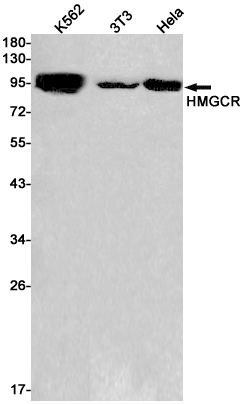
| WB | 1/500-1/1000 | Human,Mouse,Rat |
| IF | 1/20 | Human,Mouse,Rat |
| IHC | 咨询技术 | Human,Mouse,Rat |
| ICC | 技术咨询 | Human,Mouse,Rat |
| FCM | 咨询技术 | Human,Mouse,Rat |
| Elisa | 咨询技术 | Human,Mouse,Rat |
| Aliases | LDLCQ3 |
| Entrez GeneID | 3156 |
| WB Predicted band size | Calculated MW: 97 kDa; Observed MW: 97 kDa |
| Host/Isotype | Rabbit IgG |
| Antibody Type | Primary antibody |
| Storage | Store at 4°C short term. Aliquot and store at -20°C long term. Avoid freeze/thaw cycles. |
| Species Reactivity | Human,Mouse |
| Immunogen | A synthetic peptide of human HMGCR |
| Formulation | Purified antibody in TBS with 0.05% sodium azide,0.05%BSA and 50% glycerol. |
+ +
以下是关于HMGCR抗体的3篇参考文献及其摘要概括:
---
1. **文献名称**:*Autoantibodies against 3-hydroxy-3-methylglutaryl-coenzyme A reductase in patients with statin-associated autoimmune myopathy*
**作者**:Mammen AL, Chung T, Christopher-Stine L, et al.
**摘要**:该研究首次报道了HMGCR抗体与他汀类药物相关自身免疫性肌病的关联。通过血清学分析发现,此类抗体在长期使用他汀类药物并发展为免疫介导坏死性肌病(IMNM)的患者中高度特异性存在,提示其可作为该疾病的生物标志物。
---
2. **文献名称**:*Immune-mediated necrotizing myopathy associated with statins: history and recent developments*
**作者**:Christopher-Stine L, Basharat P.
**摘要**:文章综述了他汀类药物诱导的坏死性肌病的临床特征及HMGCR抗体的作用。研究表明,抗体水平与疾病活动性相关,且停用他汀后仍持续存在,强调早期免疫抑制治疗的重要性。
---
3. **文献名称**:*HMGCR antibody-associated necrotizing myopathy: diagnosis and treatment*
**作者**:Werner JL, Christopher-Stine L, Ghazarian SR, et al.
**摘要**:该研究提出HMGCR抗体检测对诊断IMNM的关键作用,并发现抗体滴度随治疗降低。推荐联合免疫抑制剂(如利妥昔单抗)治疗,可显著改善患者肌力及预后。
---
**备注**:以上文献多发表于《Arthritis & Rheumatology》或《Neurology》等期刊,涵盖HMGCR抗体的临床意义、诊断价值及治疗策略。如需具体年份或页码,可进一步补充检索。
HMGCR (3-hydroxy-3-methylglutaryl-coenzyme A reductase) antibodies are autoantibodies targeting the enzyme HMGCR, a key rate-limiting enzyme in cholesterol biosynthesis. These antibodies are strongly associated with immune-mediated necrotizing myopathy (IMNM), a subtype of idiopathic inflammatory myopathy. HMGCR is also the pharmacological target of statins, which inhibit its activity to lower cholesterol. Interestingly, statin exposure can trigger autoimmune responses in genetically susceptible individuals, leading to the production of anti-HMGCR antibodies. However, some patients develop these antibodies without prior statin use, suggesting alternative triggers.
Clinically, anti-HMGCR-positive IMNM often presents with progressive proximal muscle weakness, elevated serum creatine kinase, and necrotic muscle fibers on biopsy. The antibodies are detected via immunoprecipitation or ELISA and serve as a serological marker, aiding in diagnosis and differentiating IMNM from other myopathies. Approximately 50% of IMNM cases are linked to anti-HMGCR antibodies, particularly in statin-exposed patients.
Treatment involves immunosuppressive therapies (e.g., corticosteroids, rituximab) and statin discontinuation if applicable. Persistent antibody levels may correlate with disease activity, guiding therapeutic monitoring. Research continues to explore the precise mechanisms of autoantibody generation and their role in muscle injury, offering insights into targeted therapies for this rare but debilitating condition.
×